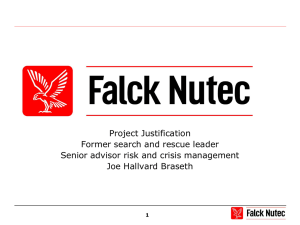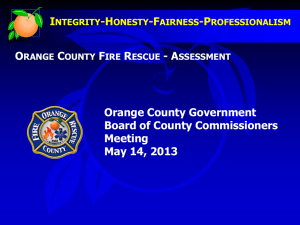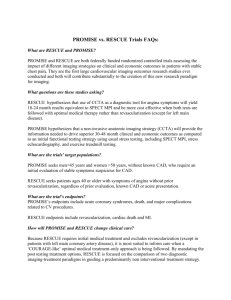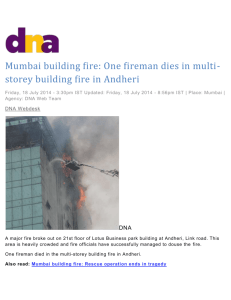AIM 1 - Prevention
advertisement
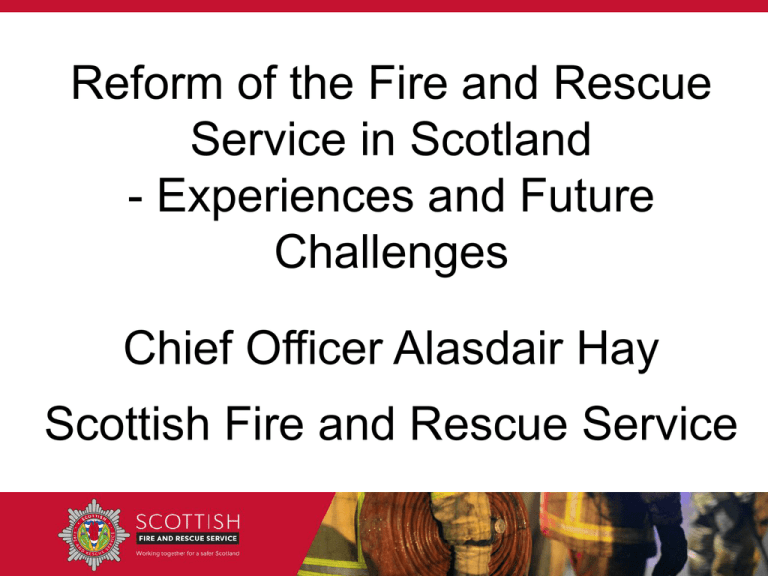
Reform of the Fire and Rescue Service in Scotland - Experiences and Future Challenges Chief Officer Alasdair Hay Scottish Fire and Rescue Service Fire (Scotland) Act 2005 Principal Fire And Rescue Functions ! Keep clear Fire exit Community Fire Safety Legislative Fire Safety Firefighting Principal Fire And Rescue Functions Fire Investigation Road Traffic Collisions Serious Transport Incidents Principal Fire And Rescue Functions Chemical, Biological, Radiological and Nuclear Incidents (CBRN) Search and Rescue Flood and Flood Rescue Scottish Fire And Rescue Service Workforce WDS 4,312 45% Control 215 2% Support 1,005 11% RDS 3,392 36% 615 6% 9,539 100% Volunteer Total Scottish Fire And Rescue Service Area SFRS Area 31,510 miles2 Households Population 5.295 million Households at Risk 2.2 million 745,922 Inhabited Islands 96 Miles of Rail Network 1,520 Unitary Authorities 32 Miles of Road Network 34,000 Business Premises 226,000 Fire Stations 375 Control Centres 8 Workshops 8 Other Buildings 75 Vehicles – Heavy 740 Vehicles - Light 771 Budget £286.8 million Emergency Incidents Police and Fire Reform (Scotland) Act 2012 Fire and Rescue Framework for Scotland 2013 Benefits Of Reform • Protecting the frontline - improving outcomes • More equitable access to specialist and national resources • Greater connection with local communities • All for less money - remove duplication Key Targets Target 1: Reducing fire fatalities and casualties by 5% a year Target 2: Reducing special services casualties Target 3: Reducing accidental dwelling fires by 10% each year Target 4: Reducing the number of non-domestic fires Target 5: Reducing firefighter injuries Target 6: Improving attendance Initial Funding Gap Projection 310,000 300,000 290,000 £20.7m £000 280,000 £34.5m £45.0m 270,000 Cost of Service 260,000 Funding 250,000 240,000 230,000 2012/13 2013/14 2014/15 Year 2015/16 LEADERSHIP CULTURE STRUCTURE RESOURCES = SUCCESS ? CULTURE STRUCTURE RESOURCES = Confusion LEADERSHIP ? STRUCTURE RESOURCES = Resistance LEADERSHIP CULTURE ? RESOURCES = Anxiety LEADERSHIP CULTURE STRUCTURE ? = Frustration LEADERSHIP CULTURE STRUCTURE RESOURCES = SUCCESS Key Areas For Financial Savings Financial savings may arise from: • • • • Reduction in staff and associated costs Asset and contract rationalisation Streamlining processes Shared services Key Early Deliverables i Review the work done to date to prepare for the start of the SFRS and make any necessary operational decisions required to ensure that the SFRS functions effectively on 1 April 2013, carrying out its statutory responsibilities and providing an effective response to incidents. Key Early Deliverables ii Ensure that the Service can operate within its approved budgets from 1 April 2013. iii Prepare options for the Board around structures. iv Appoint senior management team. v Designate number, roles and leadership of Local Senior Officers. Key Early Deliverables vi Support the Board in producing the first Strategic Plan, setting out how the SFRS will deliver its functions and meet the Scottish Government priorities as set out in the Fire and Rescue Framework. vii Ensure that robust arrangements are in place to create a new formal relationship with each of the 32 local authorities by, for example, ensuring local plans are produced which reflect national and local priorities. Questions CLOSE Chief Officer Alasdair Hay




